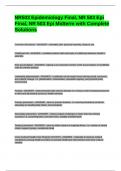NR503 Epidemiology Final, NR 503 Epi
Final, NR 503 Epi Midterm with Complete
Solutions
Common risk factors - ANSWER - unhealthy diet, physical inactivity, tobacco use
Childhood risk - ANSWER - conditions before birth and early in childhood influence health in
adult life.
Risk accumulation - ANSWER - Ageing is an important marker of the accumulation of modifiable
risks for chronic disease
Underlying determinants - ANSWER - a reflection of the major forces driving social, economic,
and cultural change. I.e. globalization, urbanization, population ageing, and general policy
environment
Poverty - ANSWER - interconnected with chronic disease in a vicious circle increasing exposure
to risks and decreased access to health services
Primary prevention - ANSWER - aims to prevent disease. I.e. banning hazardous products,
educating on healthy/safe habits, immunizations
Secondary prevention - ANSWER - reduce impact of disease or injury that has already
occurred. I.e. screening tests, low-dose ASA, suitably modified work
Tertiary prevention - ANSWER - aims to soften impact of ongoing illness. I.e. cardiac or stroke
rehab, support groups, vocational rehab
Cross Cultural Health Care Program (CCHCP) - ANSWER - materials to improve cultural
competency among health providers to provide healthcare interventions and other cultural
variants
,Marginalization - ANSWER - Major cause of vulnerability referring to exposure to a range of
possible harms
Assimilation - ANSWER - the social, economic, and political integration of a cultural group into
mainstream society to which it may have emigrated
Genetics - ANSWER - place patients at higher risk for certain disease and if family history
reveals this a screening tool could be used to determine the likelihood of a person developing
the disease
Genetic risk assessment - ANSWER - when a patient is determined to have a gene that places
them at a higher risk of having a disease such as cancer, diabetes, or cardiovascular disease
Genomics - ANSWER - study of all genes in the human genome as well as their interaction with
other genes, the individuals environment, and the influence of cultural and psychosocial factors
Pharmacogenomics - ANSWER - medication efficacy, toxicity, and drug interaction based on
genetic variations
Variables at risk for marginalization - ANSWER - high risk health literacy, cultural barriers, low
english proficiency
Cultural competence - ANSWER - a dynamic, fluid, continuous process whereby an individual,
system or health care agency find meaningful and useful care delivery strategies based on
knowledge of the cultural heritage, beliefs, attitudes, and behavior of those whom they render
care
Norms & values - ANSWER - soecific practices that guide the actions and decisions of each
person in a group based on their culture. Can be learned or shared.
Kleinman Explanatory Model - ANSWER - A set of questions that the APN can use in order to
assess the culture of a patient.
, Socioeconomic status - ANSWER - A measure that takes into account three interrelated
dimensions: a person's income level, education level, and typ of occupation.
Disparities - ANSWER - a higher burden of illness, injury, disability, or mortality experiences by
one grup relative to another
Minorities - ANSWER - a group of people who because of their physical or cultural
characteristics, are singled out from the other in society
Food desert - ANSWER - neighborhoods and communities that have limited access to
affordable and nutritious foods
Social determinants of health - ANSWER - poverty, education level, raciam, income, and poor
housisng that effect access to healthcare
Social justice theory - ANSWER - the goal that all people will have equal opportunity to
healthcare access and quality of healthcare will be the same
Data sources utilized to access determinants of health - ANSWER - Healthy People 2020, US
Census, US Department of Health and Human Services, Office of Minority Health and Health
Disparities
Accommodation - ANSWER - To create an environment that accomodates health practice and
ritual from other cultures within a plan of care
Acculturation - ANSWER - degree to which an individual from one culture has given up the traits
of that culture and adopted the traits of the dominant culture in which they now reside
Components of genetic risk assessment - ANSWER - Accurate family history for 3 generations
or genetic blood testing to reveal genes
Relationship between genetics and environment - ANSWER - a patient may have a gene
increasing risks of disease while also being exposed to environmental factors that also increase
risk for disease. i.e. lung cancer and radon gas




